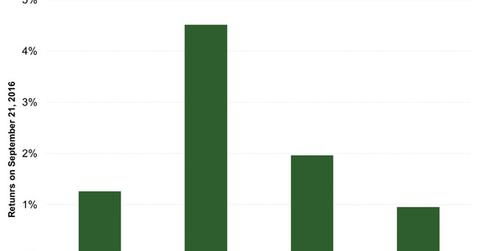Haruhiko Kuroda Says Monetary Easing Has Helped Japan
Haruhiko Kuroda gave a new theme to Japan’s monetary policy in a September 21, 2016, meeting, focusing on yield curve and monetary accommodation.
Sept. 29 2016, Published 10:21 a.m. ET

Comprehensive assessment of QQE
Haruhiko Kuroda, governor of the Bank of Japan, gave a new theme to Japan’s monetary policy in a September 21, 2016, meeting. He focused on the policy’s efforts to control the yield curve and keep monetary accommodation until inflation overshoots the 2% target.
On September 26, 2016, Kuroda addressed business leads in Osaka, where he reviewed economic activity, prices, and the impact of QQE (quantitative and qualitative monetary easing). He also gave insights into the reasoning for the newly expanded framework of the monetary policy.
While the Comprehensive Assessment carried out by the Bank of Japan is available as a detailed report, Kuroda summarized the main findings in the following four points:
- Japan is no longer in deflation due to QQE.
- The inflation target has remained elusive.
- Monetary measures have helped push down the yield curve.
- Monetary easing is impacting financial intermediation.
Japan-focused ETFs (JPXN) (JPMV) rose sharply on the day of the meeting, as you can see in the above graph.
QQE with yield control
After reviewing and summarizing the Comprehensive Assessment of QQE, Kuroda explained the new framework of QQE with yield control, which is expected to strengthen the present policy framework.
In this series, we’ll be looking at this Comprehensive Assessment in detail according to the four main findings mentioned above. We’ll also look at the new adoption of yield control and how it’s expected to fuel inflation in Japan (HEWJ) (HJPX).
Let’s begin with Kuroda’s views on how QQE has helped Japan (JPN) (SCIJ) come out of deflation.
